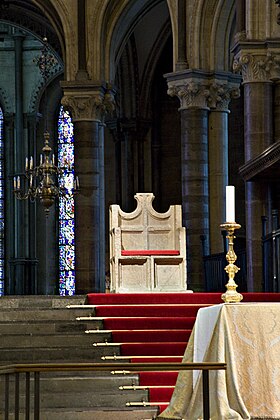
Back كاتدرائية كانتربري Arabic Catedral de Canterbury AST Kenterberi kafedralı Azerbaijani Кентэрберыйскі сабор Byelorussian Кентърбърийска катедрала Bulgarian Catedral de Canterbury Catalan Canterburská katedrála Czech Canterbury Cathedral Danish Kathedrale von Canterbury German Καθεδρικός του Κάντερμπερι Greek
| Canterbury Cathedral | |
|---|---|
| Cathedral and Metropolitical Church of Christ, Canterbury | |
 Cathedral from the city entrance | |
 | |
| 51°16′47″N 1°04′59″E / 51.2797°N 1.0831°E | |
| Location | Canterbury, Kent |
| Country | England |
| Denomination | Church of England |
| Previous denomination | Catholic Church |
| Churchmanship | Liberal Catholic |
| Website | Official website |
| History | |
| Status | Cathedral |
| Consecrated | 1070 |
| Architecture | |
| Functional status | Active |
| Heritage designation | Grade I listed |
| Designated | 3 December 1949[1] |
| Architectural type | Cruciform basilica |
| Style | Romanesque, Gothic |
| Groundbreaking | 1070 |
| Completed | 1834 (last major alteration) |
| Specifications | |
| Length | 525 ft (160 m) |
| Nave length | 178 ft (54 m) |
| Choir length | 180 ft (55 m) |
| Width | 154 ft (47 m) |
| Nave width | 71 ft (22 m) |
| Nave height | 80 ft (24 m) |
| Choir height | 71 ft (22 m) |
| Number of towers | 5 |
| Tower height | 236 ft (72 m) (crossing)[2] |
| Number of spires | 1 (now lost) |
| Spire height | 190 ft (58 m) (northwest tower, demolished 1705) |
| Bells | 14 (1981) |
| Tenor bell weight | 34-3-4 (1767 kg) |
| Administration | |
| Province | Canterbury |
| Diocese | Canterbury (since 1072) |
| Clergy | |
| Archbishop | Justin Welby, Archbishop of Canterbury |
| Bishop(s) | Rose Hudson-Wilkin, Bishop of Dover |
| Dean | David Monteith |
| Precentor | Wendy Dalyrmple (from 5 November) |
| Canon(s) | Tim Naish (Librarian) |
| Canon Missioner | Emma Pennington |
| Canon Treasurer | Andrew Dodd |
| Archdeacon | Will Adam (Canon Residentiary) |
| Laity | |
| Organist/Director of music | David Newsholme |
| Official name | Canterbury Cathedral, St Augustine's Abbey, and St Martin's Church |
| Type | Cultural |
| Criteria | i, ii, vi |
| Designated | 1988 (12th session) |
| Reference no. | 496 |
| Region | Europe and North America |
Listed Building – Grade I | |
| Official name | Christchurch Cathedral, the Cathedral Precincts |
| Designated | 13 December 1949 |
| Reference no. | 1336823 |

Canterbury Cathedral is the cathedral of the archbishop of Canterbury, the spiritual leader of the Church of England and symbolic leader of the worldwide Anglican Communion. Located in Canterbury, Kent, it is one of the oldest Christian structures in England and forms part of a World Heritage Site. Its formal title is the Cathedral and Metropolitical Church of Christ, Canterbury.[3][a]
Founded in 597, the cathedral was completely rebuilt between 1070 and 1077. The east end was greatly enlarged at the beginning of the 12th century, and largely rebuilt in the Gothic style following a fire in 1174, with significant eastward extensions to accommodate the flow of pilgrims visiting the shrine of Thomas Becket, the archbishop who was murdered in the cathedral in 1170. The Norman nave and transepts survived until the late 14th century, when they were demolished to make way for the present structures.
Before the English Reformation, the cathedral was part of a Benedictine monastic community known as Christ Church, Canterbury, as well as being the seat of the archbishop.
- ^ Cite error: The named reference
NHLECathedralwas invoked but never defined (see the help page). - ^ "A Walk Around Canterbury Cathedral". ParadoxPlace.com. Archived from the original on 3 October 2017. Retrieved 8 December 2017.
- ^ "The Constitution" (PDF). Canterbury Cathedral. July 2023. Archived (PDF) from the original on 3 November 2023. Retrieved 3 November 2023.
Cite error: There are <ref group=lower-alpha> tags or {{efn}} templates on this page, but the references will not show without a {{reflist|group=lower-alpha}} template or {{notelist}} template (see the help page).